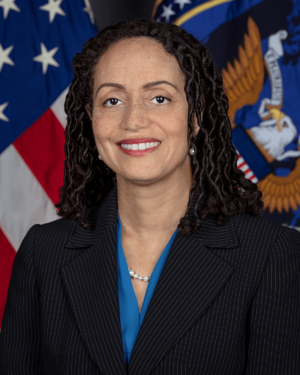Stacey Dixon facts for kids
Quick facts for kids
Stacey Dixon
|
|
|---|---|

Official portrait, 2021
|
|
| Acting Director of National Intelligence | |
| In office January 20, 2025 – January 25, 2025 |
|
| President | Donald Trump |
| Preceded by | Avril Haines |
| Succeeded by | Lora Shiao (acting) |
| 7th Principal Deputy Director of National Intelligence | |
| In office August 4, 2021 – January 25, 2025 |
|
| President | Joe Biden Donald Trump |
| Preceded by | Neil Wiley (as Principal Executive) |
| Succeeded by | Aaron Lukas (Nominee) |
| 8th Deputy Director of the National Geospatial-Intelligence Agency | |
| In office July 2019 – August 2021 |
|
| President | Donald Trump Joe Biden |
| Succeeded by | Tonya Wilkerson |
| Personal details | |
| Born | January 9, 1971 Washington, D.C., U.S. |
| Education | Stanford University (BS) Georgia Tech (MS, PhD) |
Stacey Angela Dixon (born January 9, 1971) is an American engineer and a top official in the United States intelligence community. She has served as the Principal Deputy Director of National Intelligence since August 4, 2021. This role means she is the second-highest leader in the office that oversees all U.S. intelligence agencies. She also briefly served as the Acting Director of National Intelligence in January 2025.
Contents
Stacey Dixon's Education Journey
Stacey Dixon studied mechanical engineering, which is a field about designing and building machines.
- In 1993, she earned her bachelor's degree from Stanford University.
- She then continued her studies at Georgia Tech, where she received her master's degree in 1995.
- In 2000, she completed her PhD, also in mechanical engineering, from Georgia Tech.
Stacey Dixon's Career in Intelligence
Stacey Dixon has had a long and important career working for the U.S. government's intelligence agencies. These agencies collect and analyze information to protect the country.
Early Career and Key Roles
- She started as an intern at Nokia Bell Labs.
- From 2003 to 2007, she worked at the Central Intelligence Agency (CIA). The CIA gathers information about foreign governments and events. During this time, she also worked with the National Reconnaissance Office (NRO), which designs and operates spy satellites.
- From 2007 to 2010, Dixon worked for the United States House Permanent Select Committee on Intelligence. This committee helps oversee the intelligence agencies.
- She then joined the National Geospatial-Intelligence Agency (NGA) in 2010. The NGA provides maps and satellite images for national security. At the NGA, she held several leadership roles, including working with Congress and leading research.
Leadership in Intelligence Agencies
- From 2016 to 2018, Stacey Dixon was the deputy director of the Intelligence Advanced Research Projects Activity (IARPA). IARPA focuses on developing new technologies for intelligence.
- She became the director of IARPA in 2018 and served until July 2019.
- In July 2019, she became the Deputy Director of the National Geospatial-Intelligence Agency.
High-Ranking Intelligence Position
- In April 2021, President Joe Biden announced his plan to nominate Stacey Dixon for the role of Principal Deputy Director of National Intelligence.
- She was confirmed for this position on August 3, 2021, and officially started on August 4, 2021.
- This made her the highest-ranking Black woman in the entire U.S. intelligence community.
- In January 2025, she briefly served as the Acting Director of National Intelligence. She was later replaced in that acting role by Lora Shiao.
Awards and Recognition
- In 2024, Stacey Dixon received her fifth Wash100 Award. This award recognizes top leaders in the government contracting community. She earned it for her work in making intelligence information more open and for improving how data is used.

All content from Kiddle encyclopedia articles (including the article images and facts) can be freely used under Attribution-ShareAlike license, unless stated otherwise. Cite this article:
Stacey Dixon Facts for Kids. Kiddle Encyclopedia.
